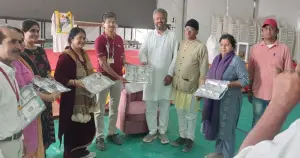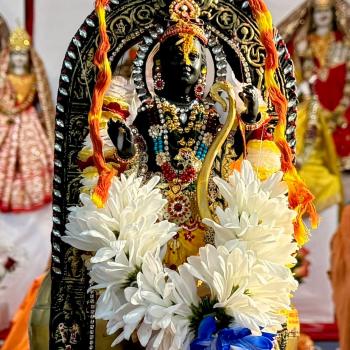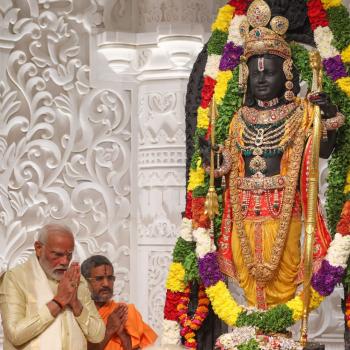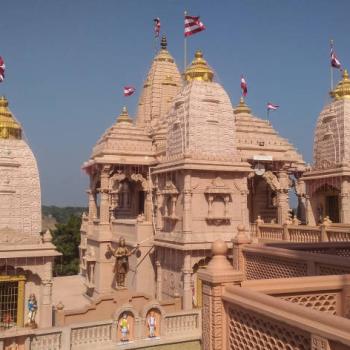
The recently concluded Maha Kumbh in Prayagraj, Bharat, is deeply rooted in Hindu tradition. It symbolizes purification and spiritual rebirth through ritualistic bathing at the confluence of three sacred rivers- the Ganges, Yamuna, and Saraswati. The latter is considered an ancient and mythologically significant river, often mentioned in the Rigveda as a mighty and sacred water body. It is now considered a subterranean river(due to climatic changes), but Hindus still believe in the Prayagraj confluence of three rivers (Triveni Sangam).
Kumbh Chronology: The Kumbh festival follows a specific cycle based on the planetary positions of Jupiter, the Sun, and the Moon. It is held at four different locations in Bharat, each associated with the sacred river(s) given below.
- Prayagraj (formerly Allahabad) in Uttar Pradesh (Triveni Sangam of Ganga, Yamuna and Saraswati Rivers)
- Haridwar in Uttarakhand (Ganga River)
- Ujjain in Madhya Pradesh (Shipra River)
- Nashik in Maharashtra (Godavari River)
| Type of Kumbh Mela | Held At | Frequency |
| Maha Kumbh Mela | Prayagraj (only) | Every 144 years (after 12 full cycles of 12 years) |
| Purna Kumbh Mela | Prayagraj, Haridwar, Ujjain, Nashik | Every 12 years |
| Ardh Kumbh Mela | Prayagraj, Haridwar | Every 6 years |
| Kumbh Mela (Magh Mela or Mini Kumbh) | Prayagraj (as Magh Mela) | Every 3 years (rotates among the four sites) |
The Maha Kumbh in 2025
The massive turnout of an estimated 663 million reflects the enduring significance of this ritual and a resurgence of public expression in the Hindu faith. Initially, about 500 million people were expected over about six weeks. Accordingly, all logistical arrangements were made. However, nearly 25% more devotees from all over the world flocked to Prayagraj. No one would have memories, lessons learned, and/or best practices from the last Maha Kumbha (144 years ago) when Bharat was still under the British Raj. The Maha Kumbh was attended by the young and old, men and women, from all corners of Bharat and abroad knowing that the next one will not be in their lifetime.
I did not visit Maha Kumbh personally but followed it from afar. I was continuously inspired, challenged, and motivated to watch the gathering on various Indian TV channels. While it was a resurgence of Sanatan Dharma, there were challenges like crowd control, transportation, security/safety, food, water, sanitation, and living accommodations. Unfortunately, a couple of fire incidents and a stampede resulted in the loss of lives. Even one death is too many but by Divine’s grace, the unexpected turn of events like fire, stampede, and delays in bathing on auspicious days were managed very well in the larger context.
The Unimaginable Magnitude: That motivation led me to imagine the unimaginable magnitude of Maha Kumbha. In a published article elsewhere, I summed it up as follows, “Such human gathering exceeds most continents’ populations, dwarfs any military or migration event, surpasses digital engagement records, and rivals even the largest human mobilizations ever recorded. This makes the 2025 Maha Kumbh the largest human gathering ever witnessed on Earth.”
Equally unfathomable is that over 76 million devotees took the holy dip (Amrit Snan) in one day (January 29, the auspicious Mauni Amavashya). In the U.S. context, the combined population of the 50 biggest cities is only about 50 million. Another dimension to imagine is that the combined population of the world’s largest cities, Tokyo (~37 million) and Delhi (~34 million), is less than the Hindu devotees taking the holy dip in one day.
This unparalleled religious congregation of Hindus has no comparable event in Islam and Christianity, the other two large religions of the world. The Kumbha Mela also initiated an innovative, inspiring, and unique “green” initiative, a lesson for all of us. Read below about it.
The ‘One Thaila – One Thali’ (OT-OT) initiative
Introduced during the 2025 Maha Kumbh Mela in Prayagraj, the initiative translates to One Bag- One Plate. More importantly, the focus is on the reusable and recyclable Thaila made of cloth, and the stainless steel Thali. While the world has gone crazy in using disposable plastic bags and Styrofoam plates, OT-OT promotes environmentally friendly and sustainable Thaila and Thali thus reducing plastic waste.

The OT-OT was spearheaded by the Rashtriya Swayamsevak Sangh (RSS) and Paryavaran Sanrakshan Gatividhi (PSG). I was in Bharat in December when the initiative was underway and the RSS was actively promoting it. I also took pride in contributing to the cause. The RSS workers, including my nephew, went door to door and asked for a voluntary contribution of INR 100 (about $1.20) for the OT-OT.
Key Aspects of the OT-OT and its Environmental Impact:
Collection and Distribution: Volunteers conducted extensive door-to-door campaigns across Bharat, collecting over 15 million steel plates and cloth bags. These items were then distributed free of cost to pilgrims, seers, and saints for their use instead of disposable alternatives.
Environmental Impact: It significantly reduced the use of single-use plastics and disposable items, aligning to make the Maha Kumbh a ‘Harit Kumbh’ (Green Kumbh). This effort prevented ~ 29,000 tons of plastic waste from being generated during the event.
Community Engagement: The campaign resonated with people across Bharat, including those unable to attend the Kumbh. Many contributed toward OT-OT in cash or by donating plates and bags, fostering a sense of pride and participation in the grand spiritual gathering of Sanatanis at Prayagraj.
Support from Religious Camps: Various religious camps and organizations supported the initiative. For instance, the Mani Ram Das camp donated 200,000 steel glasses to the Kumbh administration to further reduce plastic usage.
Waste Reduction: The campaign led to an 80-85% decrease in the use of disposable plates and bowls, significantly cutting down non-biodegradable waste. This eliminated approximately 29,000 tons of waste collection, reducing the burden on sanitation workers and city waste management systems.
Financial Savings: By eliminating the need for disposable dining ware, the initiative saved an estimated $19 million over the 45-day Maha Kumbha festival period.
Environmental Awareness: The initiative educated millions and reinforced clean and eco-friendly practices, emphasizing the importance of maintaining clean water bodies like rivers and lakes.
Overall, the ‘One Thaila – One Thali’ campaign promoted environmental consciousness and united communities in a collective effort to preserve the sanctity and cleanliness of the Maha Kumbh.
For a visual insight into this initiative, the YouTube video is informative:
In summary, the ‘One Thaila – One Thali’ initiative, marked a significant advancement in environmental conservation efforts at the festival. While previous Kumbh Melas have implemented various eco-friendly measures, this initiative was unprecedented in scale and impact on community involvement, waste reduction, and sustainability.
















